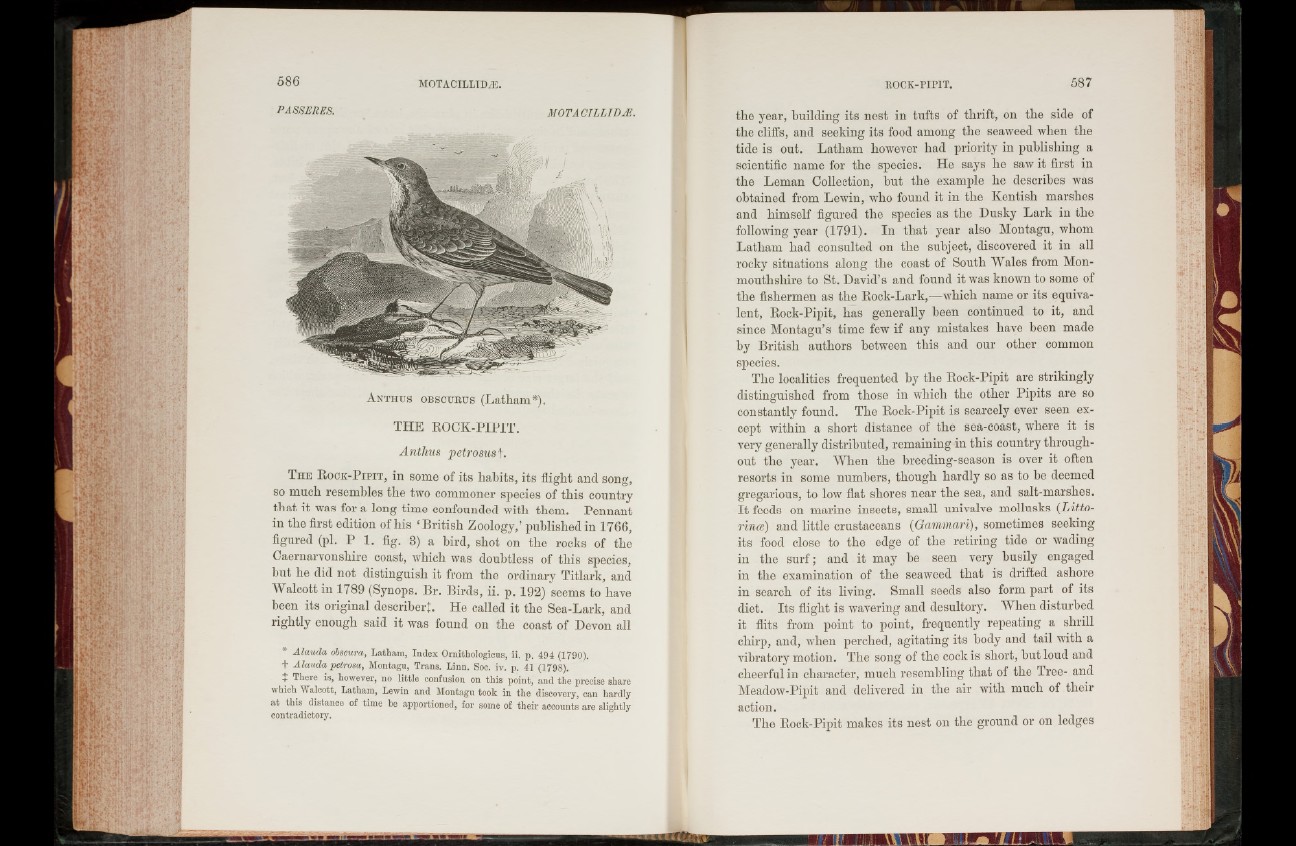
A n t h u s o b sc u r u s (Latham*).
THE ROCK-PIPIT.
Anthus petrosus t.
T h e R ock- P i p i t , in some of its habits, its flight and song,
so much resembles the two commoner species of this country
that it was for a long time confounded with them. Pennant
in the first edition of his ‘British Zoology,’ published in 1766,
figured (pi. P 1. fig. 3) a bird, shot on the rocks of the
Caernarvonshire coast, which was doubtless of this species,
but he did not distinguish it from the ordinary Titlark, and
Walcott in 1789 (Synops. Br. Birds, ii. p. 192) seems to have
been its original describer*. He called it the Sea-Lark, and
rightly enough said it was found on the coast of Devon all
* Alauda obscura, Latham, Index Ornithologicus, ii. p. 494 (1790).
+ Alaudapetrosa, Montagu, Trans. Linn. Soc. iv. p. 41 (1798).
.+. There is, however, no little confusion on this point, and the precise share
which Walcott, Latham, Lewin and Montagu took in the discovery, can hardly
at this distance of time be apportioned, for some of their accounts are slightly
contradictory.
the year, building its nest in tufts of thrift, on the side of
the cliffs, and seeking its food among the seaweed when the
tide is out. Latham however had priority in publishing a
scientific name for the species. He says he saw it first in
the Leman Collection, hut the example he describes was
obtained from Lewin, who found it in the Kentish marshes
and himself figured the species as the Dusky Lark in the
following year (1791). In that year also Montagu, whom
Latham had consulted on the subject, discovered it in all
rocky situations along the coast of South Wales from Monmouthshire
to St. David’s and found it was known to some of
the fishermen as the Rock-Lark,—which name or its equivalent,
Rock-Pipit, has generally been continued to it, and
since Montagu’s time few if any mistakes have been made
by British authors between this and our other common
species.
The localities frequented by the Rock-Pipit are strikingly
distinguished from those in which the other Pipits are so
constantly found. The Rock-Pipit is scarcely ever seen except
within a short distance of the sea-coast, where it is
very generally distributed, remaining in this country throughout
the year. When the breeding-season is over it often
resorts in some numbers, though hardly so as to be deemed
gregarious, to low flat shores near the sea, and salt-marshes.
I t feeds on marine insects, small univalve mollusks (Litto-
rince) and little crustaceans (Gammari), sometimes seeking
its food close to the edge of the retiring tide or wading
in the su rf; and it may he seen very busily engaged
in the examination of the seaweed that is drifted ashore
in search of its living. Small seeds also form part of its
diet. Its flight is wavering and desultory. When disturbed
it flits from point to point, frequently repeating a shrill
chirp, and, when perched, agitating its body and tail with a
vibratory motion. The song of the cock is short, but loud and
cheerful in character, much resembling that of the Tree- and
Meadow-Pipit and delivered in the air with much of their
action.
The Rock-Pipit makes its nest on the ground or on ledges